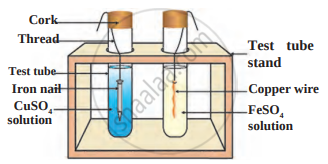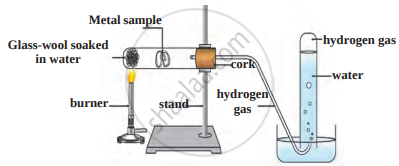Advertisements
Advertisements
प्रश्न
Give reason:
Sodium, potassium and lithium are stored under oil.
उत्तर
- All three metals react with water, producing a lot of heat. As a result, hydrogen evolves and catches fire.
- They cannot be kept in the air because air contains moisture or water vapours. They are kept under kerosene to avoid contact with both air and water.
संबंधित प्रश्न
Give two examples of amphoteric oxides.
Name two metals which will displace hydrogen from dilute acids, and two metals which will not.
What are amphoteric oxides?
Example of an amphoteric oxide is:
Which of the following metals liberate hydrogen with 5% HNO3?
(i) Cu
(ii) Zn
(iii) Mn
(iv) Mg
Which of the following oxide(s) of iron would be obtained on prolonged reaction of iron with steam?
Stainless steel is very useful material for our life. In stainless steel, iron is mixed with
If copper is kept open in air, it slowly loses its shining brown surface and gains a green coating. It is due to the formation of
When a metal X is treated with cold water, it gives a basic salt Y with molecular formula XOH (Molecular mass = 40) and liberates a gas Z which easily catches fire. Identify X, Y and Z and also write the reaction involved.
Which of the following reacts with cold water vigorously?
The metal which produces hydrogen gas on reaction with dilute hydrochloric acid as well as sodium hydroxide solution is
Zinc sulphate forms a colourless solution in water. Will you observe any colour on adding copper turning in it?
Material: Copper wire, Iron nail, Beaker or Big test tube.
Chemicals: Ferrous Sulphate and Copper Sulphate Solution.
- Which reaction you will study with the help of the above material and solutions? Draw the diagram of the experiment arrangement.
- How do you identify that the reaction is carried out?
- Which type of reaction did you observe?
Answer the questions based on the figure below:

- Which experiment setup is demonstrated in the figure?
- What do you conclude after the reactions? Name reaction.
Answer the questions based on the figure below:

- Which reaction is shown in the figure?
- Which gas is evolved in the reaction?
- Give an example of reactants that rapidly show this reaction. Give equations.
- Give an example of reactants that do not react rapidly.
- In what condition will reactants of (c) part react? Give equation.
Select the appropriate state symbols of the products given as X and Y in the following chemical equation by choosing the correct option from table given below:
\[\ce{Zn_{(s)} + H_2SO_{4(l)} ->ZnSO_{4(X)} + H_{2(Y)}}\]
On adding dilute sulphuric acid to a test tube containing a metal ‘X’, a colourless gas is produced when a burning match stick is brought near it. Which of the following correctly represents the metal ‘X’?
